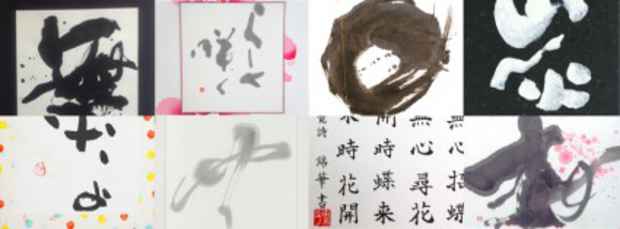“Transitory - Contemporary Japanese Calligraphy” Exhibition
Onishi Gallery

This event has ended.
Onishi Project presents “Transitory_Contemporary Japanese Calligraphy”, an exhibition featuring seven outstanding contemporary Japanese calligraphers.
Contemporary Japanese calligraphy or shodo is a unique art form, which allows the artist to explore a space of personal expression in an otherwise rigid world. A departure from the rules of traditional calligraphy, the contemporary genre offers a more personal and abstract interpretation of brush painting. Each work reflects a transitory moment, the artist’s mood and subsequent brushstrokes uncertainties to be fixed in charcoal ink. The Japanese concept of utsuroi (transitory) refers to the perception of transience: an awareness of things fading and growing, shadows shifting in the light, space as a moment in the continual process of change. For centuries, Japanese calligraphers have been fascinated by the theme of utsuroi marked in the subtle changes of the season and of the spirit. The exhibition presents the beauty and nuance of a transitory existence through the lens of seven different artists. Masako Inkyo’s demonstration will reveal the Buddhist theme of impermanence in The Tale of Heike.
Masako Inkyo began Japanese calligraphy (shodo) training at the age of three. She received her degree at the Japanese Calligraphy Department at Yasuda University, and is a member of the three largest shodo professional associations in Japan. In all three, Inkyo holds the highest rank based on the work she has submitted. She has also received many awards, including first prizes in both shodo and pen calligraphy in national competitions sponsored by the Ministry of Education. In 2010, Inkyo was selected to be the official artist of Nissan Infiniti to create car advertisements. She has been a shodo instructor at Japan Society New York for over 10 years, and continues to teach there today.
Born in Tokyo in 1960, Mitsutaka Kawashima is a calligrapher and graphic designer. While attending The Musashino University of Art, he started working as a director for events, product design, and store identity programs. During the last 15 years, he created graphics and calligraphy for over 200 restaurants and bars in Japan. His calligraphy work is recognized for its warmth and highly reputed among customers. In April 2013, he had a solo exhibition, “Calligraphy Bar,” at Gallery MU in Tokyo.
Kiyo Imaizumi calls herself Rakushoka (fun calligrapher), and trademarked the title. She creates calligraphy combining traditional calligraphy and other art forms, expressing the image of words in brush strokes. Her title reflects a fun and playful approach to free expression in calligraphy, experimenting with calligraphy on photography, or combining English and Kanji (Chinese characters). Her work includes signage, decorative calligraphy, and calligraphy performances. She has had number of solo shows in Japan, and a three persons show in Germany. She is a member of Japan Design Calligrapher’s Association.
Born in 1976, Rimi Takasu began to study calligraphy at the age of 5 at Gakusho-in. She holds the fourth degree in Gakusyo-in style calligraphy and teaches calligraphy at Atelier 246 Sho-kai in Kanagawa prefecture. Takasu is interested in expressing experiences and thoughts through calligraphy, where she aims to bring out “what does not have a form, or is not yet formed, but exists.” She uses events, stories, and poems to project her abstract thoughts and feelings into the world of calligraphy. The embodied abstraction generates new stories, which in turn inspire others. Takasu strives for a collaborative process like that of Japanese renga poetry.
Ryoyu uses ordinary words to create touching and evocative calligraphy. Facing the paper and holding a shodo brush, she is at one with her natural self. Ryoyu discovered the joy of calligraphy at age 5, and has since been expressing words of her everyday life. She works as an independent calligrapher while she continues to study under her master. Her work is popular for its warm words, and she has held solo shows all over Japan, and New York City. She organized the project “Workshop: Playing with Children in the Island and Calligraphy” in Miyakojima island and Yakushima island.
Satoshi Katayama was in 1975 in Toyama prefecture. As a child, he loved to paint, but didn’t have any experience with calligraphy. While working as a public official at the city hall in Toyama, his passion was playing soft tennis. Meanwhile, he started to work at cultural events such as lectures and movie screenings, where he met a poet who improvised words and gifted them to the audience. Looking at people delighted by his words, Katayama decided to become a calligrapher. He taught himself calligraphy by copying the old masters’ work. He performs “I see you and give words to you” at various events and department stores in Japan. In 2012, Katayama performed at Union Square in New York and plans to perform in London and Paris in August this year.
Yumiko Tomita has been practicing Japanese calligraphy (shodo) since she was 7. In 1983, she joined Kakushin Shodo School, one of the renowned artistic calligraphy organizations in Japan, and obtained a master certificate in 2007. Her calligraphy has been selected for the Sankei Shinbun National Exhibition numerous times. She has been an independent calligrapher since her relocation to the United States. Since her move, she has been researching the relationship between the “mind” and “calligraphy.” In 2012, she opened a calligraphy studio for people who are familiar with shodo. She also has a master certificate of Ikebana flower arrangement from the Ohara School, and is a certified Japanese teacher.
Media
Schedule
from July 18, 2013 to July 31, 2013
Opening Reception on 2013-07-25 from 18:00 to 20:00